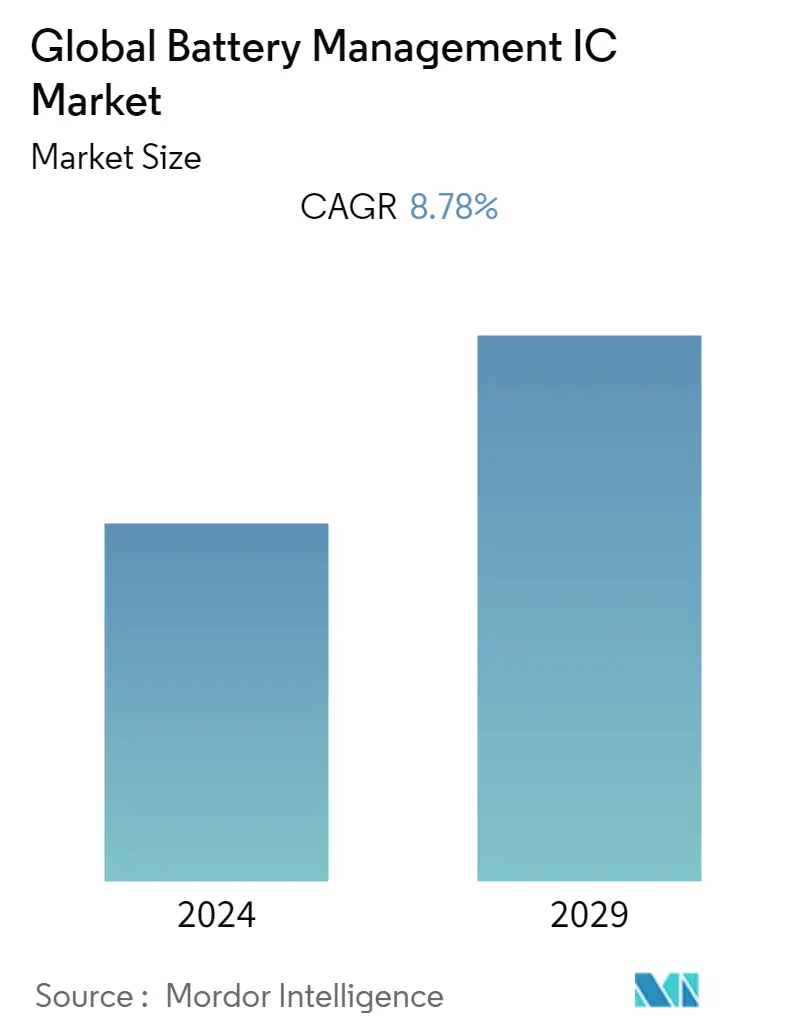Market Size of Global Battery Management IC Industry

| Study Period | 2019 - 2029 |
| Base Year For Estimation | 2023 |
| CAGR | 8.78 % |
| Fastest Growing Market | Asia-Pacific |
| Largest Market | Asia-Pacific |
| Market Concentration | Medium |
Major Players_(1).webp)
*Disclaimer: Major Players sorted in no particular order |
Battery Management IC Market Analysis
The Battery Management IC Market is expected to grow at a CAGR of 8.78% over the forecast period (2022-2027). Battery management ICs are integrated circuits that control rechargeable batteries in electronic systems. These are small electronic components such as transistors and diodes on a semiconductor chip, among others. The battery management IC safeguards the battery from running outside of the SOA (Safe Operating Area) and monitors, authenticates, calculates, and reports data, among other things. Different types of battery management ICs exist, depending on their functionality and specifications.
Battery management integrated circuits (ICs) are used in any rechargeable battery chemistry, including Li-Ion, LiFePO4, lead acid, and nickel-based batteries for wired and wireless applications. Smart cities and IoT further drive the demand for smart batteries, thereby contributing to the demand for battery management ICs. An effective battery charger boosts capacity, improves battery life, and keeps track of the charging process.
Rapid technical advancements, increased urbanization, improved consumer purchasing, and rising living standards have increased consumer electronics device consumption, culminating in an ongoing demand for batteries, cells, and packaging solutions. Furthermore, the growing use of electric vehicles to reduce the world's pace with a fast carbon footprint has increased the demand for lithium-ion batteries.
Battery management integrated circuits use advanced technology. Its integration procedure is too intricate, necessitating the use of highly skilled experts in order to manufacture it. Assembling the entire circuit also requires a high level of expertise, slowing down the process, which is a challenge for the battery management ICs market.
Wearables, industrial IoT such as smart cards and electronic shelf labels, and portables have become progressively popular in recent years due to the proliferation of battery-powered electronic gadgets. To improve usability and convenience, these gadgets must be made smaller and thinner to improve design and functionality, and enable bigger battery capacity and lower power consumption. This has led to significant product innovations that are contributing to the market growth rate.
Battery Management IC Industry Segmentation
The Battery Management Market is Segmented by Type (Fuel Gauge IC, Battery Charger IC, Authentication IC), Application (Automotive, Consumer Electronics, Industrial, Communication), and Geography.
| By Type | |
| Fuel gauge IC | |
| Battery Charger IC | |
| Authentication IC |
| By Application | |
| Automotive | |
| Consumer Electronics | |
| Industrial | |
| Communication | |
| Others |
| Geography | |
| North America | |
| Europe | |
| Asia-Pacific | |
| Latin America | |
| Middle-East and Africa |
Global Battery Management IC Market Size Summary
The Battery Management IC market is poised for significant growth, driven by the increasing demand for rechargeable batteries across various sectors, including consumer electronics, electric vehicles, and smart city applications. These integrated circuits are crucial for managing the performance and safety of batteries, ensuring they operate within safe parameters while optimizing their lifespan and efficiency. The market is experiencing a surge in demand due to rapid technological advancements, urbanization, and the rising adoption of electric vehicles, which require sophisticated battery management solutions to enhance performance and safety. The complexity of integrating these ICs, however, poses challenges, necessitating skilled expertise for their manufacturing and assembly.
Regionally, Asia-Pacific is emerging as the fastest-growing market, fueled by its robust electronics and automotive manufacturing base, with countries like China, Japan, Taiwan, and South Korea leading in semiconductor production. The region's strong consumer electronics sector and increasing manufacturing investments further bolster market growth. Global players such as ST Microelectronics, Analog Devices, and NXP Semiconductors are actively contributing to market advancements through innovative product launches and strategic partnerships. The market's expansion is also supported by significant investments in electric vehicle infrastructure and technology, particularly in China, which has seen substantial growth in EV sales.
Global Battery Management IC Market Size - Table of Contents
-
1. MARKET INSIGHTS
-
1.1 Market Overview
-
1.2 Porter's Five Forces Analysis
-
1.2.1 Bargaining Power of Buyers/Consumers
-
1.2.2 Bargaining Power of Suppliers
-
1.2.3 Threat of New Entrants
-
1.2.4 Threat of Substitute Products
-
1.2.5 Intensity of Competitive Rivalry
-
-
1.3 Industry Value Chain Analysis
-
1.4 Assessment of the Impact of COVID -19 on the Market
-
-
2. MARKET SEGMENTATION
-
2.1 By Type
-
2.1.1 Fuel gauge IC
-
2.1.2 Battery Charger IC
-
2.1.3 Authentication IC
-
-
2.2 By Application
-
2.2.1 Automotive
-
2.2.2 Consumer Electronics
-
2.2.3 Industrial
-
2.2.4 Communication
-
2.2.5 Others
-
-
2.3 Geography
-
2.3.1 North America
-
2.3.2 Europe
-
2.3.3 Asia-Pacific
-
2.3.4 Latin America
-
2.3.5 Middle-East and Africa
-
-
Global Battery Management IC Market Size FAQs
What is the current Global Battery Management IC Market size?
The Global Battery Management IC Market is projected to register a CAGR of 8.78% during the forecast period (2024-2029)
Who are the key players in Global Battery Management IC Market?
Analog Devices Inc., Renesas Electronics Corporation, NXP Semiconductors N.V, ST Microelectronics and Microchip Technology Inc. are the major companies operating in the Global Battery Management IC Market.

